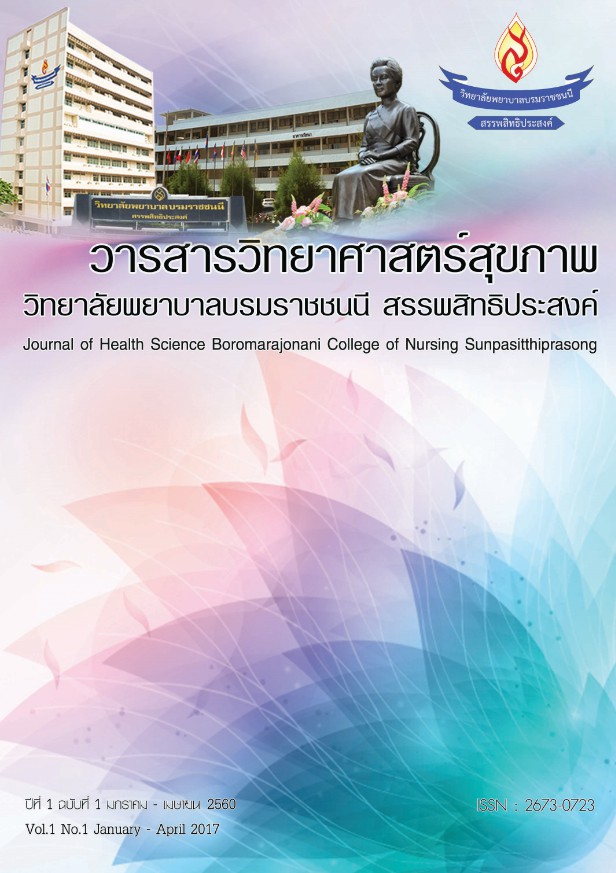บทบาทพยาบาลในการดูแลผู้ป่วยที่ใส่เครื่องกระตุ้นหัวใจชนิดถาวร : การทบทวนวรรณกรรมแบบบูรณาการ
คำสำคัญ:
เครื่องกระตุ้นหัวใจชนิดถาวร, การพยาบาล, ภาวะแทรกซ้อน, ผู้สูงอายุบทคัดย่อ
ผู้ป่วยหัวใจเต้นช้าเนื่องจากความเสื่อมของเซลล์นำไฟฟ้าหัวใจพบได้บ่อยในผู้ป่วยโรคกล้ามเนื้อหัวใจตายเฉียบพลันและผู้สูงอายุ จำเป็นต้องได้รับการรักษา โดยการใส่เครื่องกระตุ้นหัวใจชนิดถาวร Permanent pacemaker (PPM) อย่างไรก็ตามองค์ความรู้ในเรื่องนี้ยังมีจำกัด จึงได้ทบทวนรายงานการศึกษาต่างๆ โดยมีวัตถุประสงค์เพื่อสังเคราะห์องค์ความรู้เกี่ยวกับบทบาทพยาบาลและการดูแลผู้ป่วยที่ใส่เครื่องกระตุ้นหัวใจชนิดถาวร ซึ่งใช้การทบทวนวรรณกรรมแบบบูรณาการของ Cooper สืบค้นโดยใช้คำสำคัญในการสืบค้นจากฐานข้อมูล จากรายงานทั้งหมด 16 เรื่อง มีทั้งงานวิจัยและรายงานผู้ป่วย ซึ่งส่วนใหญ่ศึกษาในประเทศตะวันตก กลุ่มตัวอย่างมีตั้งแต่ 1-5,200 คน อายุเฉลี่ย 67.86 ปี อายุระหว่าง 33-88 ปี ผลการสังเคราะห์พบ 3 ประเด็นหลักดังนี้ 1) ภาวะแทรกซ้อนที่พบได้บ่อยในผู้สูงอายุ ได้แก่ (1) การทางานของเครื่องผิดปกติ พบ4.9% (2) การติดเชื้อผิวหนังที่ทำการฝังเครื่อง กระตุ้นไฟฟ้า พบ0.7% (3) การเกิดหลอดเลือดดำส่วนบนอุดตันและ (4) การเกิดก้อนลิ่มเลือด พบ 5.2% พบได้สูงในผู้ป่วยที่ได้รับยา DAPT 2) การปรับตัวและคุณภาพชีวิตของผู้ป่วยที่ใส่ PPM พบว่าผู้ป่วยมีความวิตกกังวลและความเครียดสูง และคุณภาพชีวิตด้านจิตใจและจิตวิญญาณต่ำ และรู้สึกว่าชีวิตมีข้อจำกัด 3) บทบาทพยาบาลในการดูแลพบว่า พยาบาลจะต้องมีความรู้ ความสามารถในการประเมินภาวะแทรกซ้อนได้ และมีการจัดโปรแกรมให้คาปรึกษาเพื่อลดความวิตกกังวล การจัดการความเครียด รวมทั้งการใช้โทรศัพท์ติดตามอาการหลังการใส่เครื่อง PPM ดังนั้น การพัฒนาสมรรถนะพยาบาลมีความจำเป็น ในการดูแลผู้ป่วยที่ใส่เครื่อง PPM เพื่อช่วยให้ผู้ป่วยสามารถปรับตัวอยู่กับเครื่องกระตุ้น PPM ได้อย่างปลอดภัยและมีคุณภาพชีวิตที่ดี
เอกสารอ้างอิง
Cooper H. Synthesizing research: A guide for literature reviews. 3rd ed. London: SAGE Publications; 1998.
Rasmussen L, O’Conner M, Shinkle S, Thomas MK. The basic research review check list. J Contin Educ Nurs 2000;31:13-7.
Petit-Clair N. Modified NPWT using round channel drain for pacemaker pocket non-healing complex wound: a case report. J Wound Care 2014;23:453-5.
Thal S, Moukabary T, Boyella R, Shanmugasundaram M, Pierce MK, et al. The Relationship between Warfarin Aspirin and Clopidogrel continuation in the Peri-procedural period and the Incidence of hematoma formation after Device implantation. Pacing Clin Electrophysiol 2010;33:385-8.
Mandal S, Pande A, Mandal D, Kumar A, Sarkar A, Kahali D, et al. Permanent pacemaker-related upper extremity deep vein thrombosis: a series of 20 cases. Pacing Clin Electrophysiol 2012;35:1194-8.
Bayliss CE, Beanlands DS, Baird RJ. The pacemaker-twiddler’s syndrome. A new complication of implantable tranvenouse pacemaker. Can Med Assoc J 1968;99:371-3.
Jaaf ari N, Bachollet MS, Paillot C, Amiel A, Rotge JY, Lafay N, et al. Obsessive compulsive disorder in a patient with Twiddler’s syndrome: case report. Pacing Clin Electrophysiol 2009;32:399-402.
Grapsa J, Wing MK, Fox KF. Fiddling with the pacemaker: Twiddler’s syndrome in parkinsonian patient. Perfusion 2012;28:31-3.
Vlay SC. Reverse Twiddler’s syndrome. Pacing Clin Electrophysiol 2009; 32:146.
Scholten MF, Thornton AS, Theuns DA, Res J, Jordanens LJ. Twiddler’s syndrome detected by home monitoring device. Pacing Clin Electrophysiol 2004;27:1151-2.
Palmer SJ. Post-implantation pacemaker complications: the nurse’s role in management. British Journal of Cardiac Nursing 2014;9:592-8.
Ofman P, Rahilly Tierney C, Djousse L, Peralta A, Hoffmeister P, Gaziano JM, et al. Pacing system malfunction is a rare cause of hospital admission for syncope in patients with a permanent pacemaker. Pacing Clin Electrophysiol 2013;36:109-12.
Lakkireddy D, Valasareddi S, Ryschon K, Basarkodu K, Rovang K, Mohiuddin SM, et al. The Impact of Providine-Iodine Pocket Irrigation Use on Pacemaker and Defibrillator Infection. Pacing Clin Electrophysiol 2005;28:789-94.
Thal S, Moukabary T, Boyella R, Shanmugassundaram M, Pierce MK, Thai H. The relationship between warfarin, aspirin, and clopidogrel continuation in the peri-procedural period and the incidence of hematoma formation after device implantation. Pacing Clin Electrophysiol 2010;33:385-8.
Armaganijan L, et al. Are elderly patients at increased risk of complications following pacemaker implantation? meta –analysis of randomized trials. Pacing Clin Electrophysiol 2012;35:131-4.
Norgaard ML, Melchior T, Wagner T, Haugan K. Suicide attempt by complete self-removal of a 12-year-old permanent pacemaker system: case report. J Cardiovasc Electrophysiol 2014;25:99-100.
Kurucova R, Ziakova K, Gurkova E, Simkova E. Quality of life of Patients with a Permanent Pacemaker. Central European Journal of Nursing and Midwifery 2014;5:15-20.
Tagney J. A literature review comparing the experiences and emergent needs of adult patients with permanent pacemakers (PPMs) and implantable cardioverter defibrillators (ICDs). J of Clinical Nursing; 2010:2081-9.
Davies A. Permanent pacemaker: An overview. British Journal of Cardiac Nursing 2009;4:262-9.
Ali NS, Youssef W, Mohamed A, Hussein A. Nurses’ knowledge and practice regarding implantable cardiac devices in Egypt. Journal of Cardiac Nursing 2015;10:34-40.
ดาวน์โหลด
เผยแพร่แล้ว
รูปแบบการอ้างอิง
ฉบับ
ประเภทบทความ
สัญญาอนุญาต
บทความที่ได้รับการตีพิมพ์เป็นลิขสิทธิ์ของวารสารวิทยาศาสตร์สุขภาพ วิทยาลัยพยาบาลบรมราชชนนี สรรพสิทธิประสงค์ ข้อความที่ปรากฏในบทความแต่ละเรื่องเป็นความคิดเห็นส่วนตัวของผู้เขียนแต่ละท่านไม่เกี่ยวข้องกับวิทยาลัยพยาบาลบรมราชชนนี สรรพสิทธิประสงค์ และคณาจารย์ท่านอื่นๆ ในวิทยาลัยพยาบาลฯ ความรับผิดชอบเกี่ยวกับบทความแต่ละเรื่องผู้เขียนจะรับผิดชอบของตนเอง



